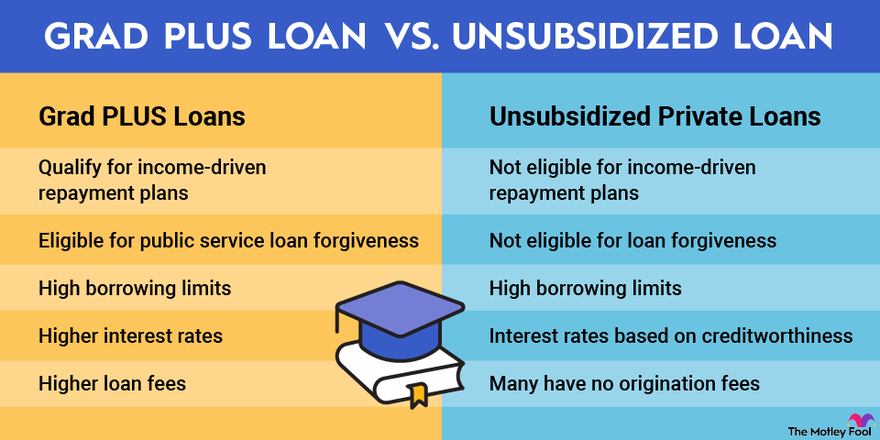
If you’re planning to attend graduate school, you have a few options when it comes to paying for it. You can use federal direct student loans or Grad PLUS loans, or you can look to the private student loan marketplace. All three options have their pros and cons, although federal direct loans are generally the best option.
However, federal direct loans might not cover the costs of attending graduate school all by themselves, so here’s what you need to know about the other types.

As mentioned, federal direct loans are typically the best option. They have lower interest rates than Grad PLUS loans, and unlike private loans, they are eligible for income-driven repayment (IDR) plans and loan forgiveness programs. Plus, unlike the other two types of loans we’ll discuss, direct loans don’t require a credit check.
The main downside to federal direct loans is their borrowing limit. Graduate students can borrow $20,500 per year in federal direct loans, which might not be enough to cover the cost of attending school.
Just as a housekeeping note, it’s worth mentioning that all graduate loans are technically unsubsidized. The technical name for the loans discussed in this section is Direct Unsubsidized Loans. A subsidized student loan is one where the government pays the interest while you’re in school or on a qualifying deferment. Subsidized direct loans are only available for undergraduate study.
Grad PLUS loans are made directly by the U.S. Department of Education and are generally designed to bridge the gap between the cost of attending graduate school and the amount a borrower can get from Direct Unsubsidized Loans. The borrowing limit for PLUS Loans is the student’s cost of attendance minus any other financial aid or student loans they have received.
There are drawbacks to Grad PLUS loans. Mainly, they are more expensive. Direct PLUS Loans have an interest rate of 8.05% for the 2023-24 school year for all borrowers, compared with 7.05% for Direct Unsubsidized Loans for grad students. They also have a loan fee equal to 4.228% of the principal, which is four times the fee for a Direct Unsubsidized Loan.
An interest rate is the cost of borrowing money or the premium you get for lending money. Learn how interest rates affect the economy.
There are some major negatives to consider when deciding if a private student loan is right for you. Most importantly, you don’t get any of the benefits that make federal student loans one of the more flexible types of debt that exist. You can’t enroll in an income-driven repayment plan, you aren’t eligible for any loan forgiveness programs, and while some lenders offer hardship deferments, they are almost certainly less flexible than federal loans.
On the other hand, there are some potential benefits to using private loans. In addition to having high borrowing limits, private student loans require a thorough credit check but offer interest rates based on your creditworthiness – so borrowers with strong credit histories might be able to get a better rate than with PLUS Loans. Plus, some of the top private lenders don’t charge origination fees at all. Compared to Grad PLUS Loans, this could save a borrower more than $2,000 if they borrow a total of $50,000 to pay for school.
Are you ready to jump into the stock market? We've got you.
While there are no penalties for paying student loans early, borrowers can be charged fees for not paying student loans on time.
Student loan consolidation allows you to roll your student loans into one, but it's not the same as refinancing.
When it comes to paying for a child’s college education, many families must weigh taking out student loans vs parent loans.
Like most financial products, there’s no perfect answer for everyone. Federal student loans -- including Grad PLUS Loans -- offer some unique features, especially when it comes to repayment flexibility. Plus, if you plan on working in the public sector, keep in mind that private loans are not eligible for Public Service Loan Forgiveness (PSLF) or any other federal forgiveness programs.
On the other hand, the fees and interest rates on Grad PLUS Loans can be significantly higher than what you can find in the private student loan market, especially if you have excellent credit. Fortunately, most private lenders will allow you to check your personalized rate and term offers with a soft credit check (no impact on your credit score) so you can make an informed decision.
Generally speaking, paying unsubsidized private student loans should be the priority over Grad PLUS Loans or any other type of federal student loans When it comes to hardship deferments and forbearance options, federal loans tend to be a lot more flexible, and you might be able to significantly lower your Grad PLUS Loan payments by enrolling in an income-driven repayment (IDR) plan, which doesn’t exist in the private sector.
Direct Graduate Unsubsidized Loans are designed to be the primary type of federal loans used by graduate students. They have generally better terms and fees compared with Direct Grad PLUS Loans, but their borrowing limits are significantly lower in most cases and may not cover your cost of attendance. Direct Grad PLUS Loans are best used to fill the gap between what you can borrow through Direct Grad PLUS Loans and what it actually costs to attend school.